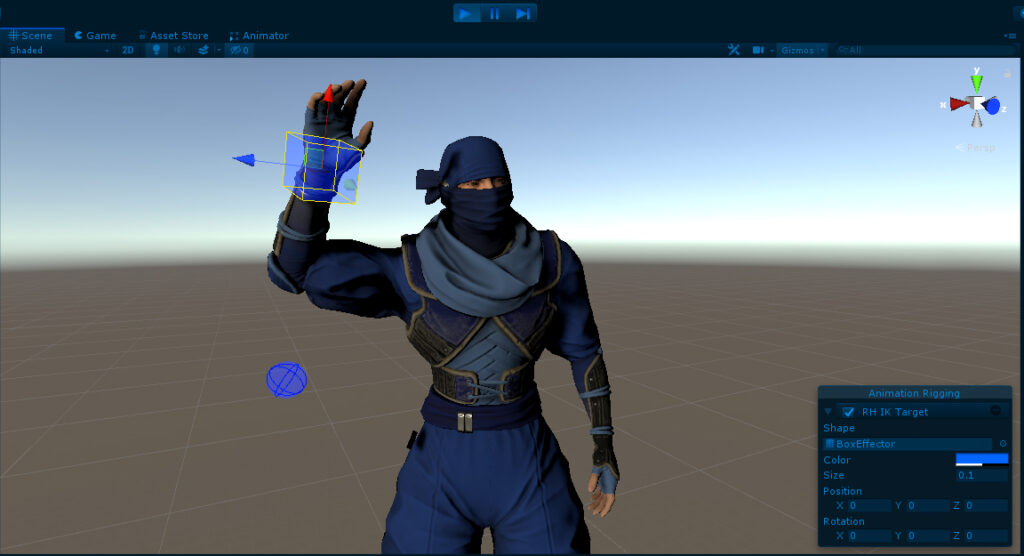Unleashing the Potential: Exploring the Future of Animation Rigging
11 min read
Are you ready to dive into the fascinating world of animation rigging and unlock its limitless possibilities? Join us as we embark on an exhilarating journey through the future of this captivating art form. From bringing characters to life with seamless movements to pushing creative boundaries with advanced technology, this blog post is your ultimate guide to unleashing the full potential of animation rigging. Get ready to be dazzled by groundbreaking techniques, cutting-edge tools, and visionary insights that will revolutionise the way we experience animated storytelling. So buckle up and prepare for a mind-blowing adventure into uncharted territory – let’s explore the future of animation rigging together!
Introduction: The Evolution of Animation Rigging
Animation rigging has come a long way since its inception in the early days of traditional hand-drawn animation. From simple wire armatures to complex digital rigs, the art and technology of animation rigging have continuously evolved to meet the demands of modern animation techniques. In this section, we will take a closer look at the history and evolution of animation rigging, exploring how it has transformed from a basic technique to an essential tool for creating dynamic and lifelike animated characters.
Early Days of Hand-Drawn Animation
The earliest form of animation can be traced back to cave paintings and ancient Egyptian hieroglyphs, where sequential images were used to create the illusion of motion. However, it was not until the late 19th century that hand-drawn animation as we know it today began to emerge. Pioneers like Émile Cohl and Winsor McCay experimented with different techniques such as flipbooks and stop-motion photography before settling on traditional hand-drawn animation using paper cells.
During this time, animators faced many challenges in bringing their characters to life. One significant obstacle was creating smooth and fluid movements for their characters without making them appear stiff or robotic. To overcome this problem, they began using wire armatures – metal skeletons that could be manipulated into different poses – inside their clay or paper-mache models. This technique allowed for greater control over character movement but was still limited in terms of flexibility and complexity.
The Rise of Digital Animation
The advent of digital animation in the 1980s revolutionised the way animations were created. With the introduction of computer-generated imagery (CGI), animators could now create more complex and detailed character movements using software programs like Autodesk Maya and Softimage. This also marked the beginning of rigging as a distinct discipline within the animation pipeline.
In the early days of digital animation, rigging was a time-consuming process that involved manually creating controls for each individual joint in a character’s body. Animators had to input every movement frame by frame, making it a tedious and labour-intensive task.
However, with advancements in technology and software capabilities, rigging became more sophisticated and efficient. Developers introduced tools like inverse kinematics (IK) and forward kinematics (FK) that allowed animators to manipulate entire chains of joints at once, speeding up the rigging process significantly.
Evolution of Rigging Techniques
As digital animation continued to evolve, so did rigging techniques. One such technique is squash and stretch, which was first introduced by Disney animators during the Golden Age of Animation in the 1930s. This technique involves exaggerating movements to give characters a more dynamic and cartoony feel.
In traditional hand-drawn animation, squash and stretch were achieved by redrawing the character’s shape in different proportions. With digital animation, this effect could be achieved by manipulating the character’s digital rig. Today, this technique is used not only in traditional hand-drawn animation but also in 3D computer-generated animation.
Another significant advancement in rigging techniques came with the introduction of facial rigs. In traditional animation, facial expressions were limited to a few basic emotions due to the difficulty of animating each individual frame. However, with the development of facial rigging tools, animators could now create a wide range of emotions and expressions for their characters.
Modern Animation Rigging
Today, animation rigging has become an essential aspect of the animation process, and advancements in technology have made it easier than ever before. Modern rigging tools like automatic weight painting and motion capture have greatly simplified the process, allowing animators to create realistic movements with minimal effort.
Furthermore, with the rise of real-time rendering engines like Unity and Unreal Engine, rigging has become even more crucial in creating dynamic and interactive animated characters for video games and other interactive media.
The evolution of animation rigging has been closely tied to technological advancements in digital animation. From its humble beginnings as a means to overcome movement limitations in hand-drawn animation, it has now become a vital tool for creating dynamic and lifelike characters in all forms of animation.
As technology continues to progress, we can expect to see even more innovations in rigging techniques that will further enhance the possibilities for animators and push the boundaries of what is possible in animation.
Current Trends in Animation Rigging
Animation rigging has come a long way since its inception, and it continues to evolve at a rapid pace. In recent years, there have been significant advancements in the field of animation rigging that have made the process more efficient, realistic, and expressive. In this section, we will delve into some of the current trends in animation rigging that are shaping the future of this exciting industry.
1. Real-time Performance:
One of the most significant trends in animation rigging is real-time performance. With the increasing demand for live events and game development, animators need to create animations that can be rendered and played back instantly. To achieve this, new techniques such as procedural animation and motion capture technology are being used to create complex rigs that can be controlled in real-time.
Procedural animation involves using algorithms to generate movement instead of manually keyframing every frame. This allows animators to create more dynamic and realistic movements without spending hours on traditional keyframe animation. Motion capture technology uses sensors or markers placed on an actor’s body to record their movements, which can then be applied to a 3D character rig in real-time.
2. Non-Linear Animation:
Traditionally, animators have followed a linear approach when creating animations – starting from pose A and ending at pose B with no deviations in between. However, with non-linear animation gaining popularity in recent years, animators now have more freedom to explore different poses and transitions between them.
Non-linear animation involves creating multiple poses for a character and blending them together to create smooth and seamless movements. This allows for more natural-looking animations that are not limited by a linear timeline.
3. Expanded Use of Motion Capture:
As mentioned earlier, motion capture technology is being used extensively in animation rigging. However, its use is no longer limited to just recording human movements. With advancements in technology, animators can now capture the movement of animals, creatures, and even inanimate objects.
This expanded use of motion capture has opened up new possibilities for animators to create more lifelike and dynamic characters with realistic movements.
4. Integration with Virtual Reality:
Virtual reality (VR) has gained significant traction in recent years, and animation rigging is also embracing this technology. VR allows animators to have a more immersive experience while creating animations, as they can see their characters move in real-time within a virtual environment.
Additionally, VR technology can also be used for motion capture, making it easier for animators to record complex movements and transfer them onto their rigs.
5. Automation:
With the increasing demand for high-quality content at a faster pace, automation has become a crucial trend in animation rigging. Automation involves using scripts or plugins to speed up repetitive tasks such as rigging and skinning.
This not only saves time but also allows animators to focus on more creative aspects of the animation process. As technology continues to advance, we can expect to see more automation tools being developed for animation rigging.
Animation rigging is constantly evolving, and these are just some of the current trends shaping its future. As technology continues to advance, we can expect to see even more innovative techniques and tools being developed to enhance the animation process.
The Future of Animation Rigging: Predictions and Technologies
The future of animation rigging is an exciting topic that has been gaining a lot of attention in recent years. With advancements in technology and the ever-evolving demands of the animation industry, it’s no wonder that there are many predictions and emerging technologies that are expected to shape the future of animation rigging.
One major prediction for the future of animation rigging is the increased use of real-time motion capture technology. This technology allows animators to capture human movements in real-time, which can then be applied to 3D characters. This not only saves time but also adds a level of realism to animations that was previously difficult to achieve. Real-time motion capture technology is already being used in video games and virtual reality experiences, and it’s predicted that it will become more prevalent in film and television production as well.
Another prediction for the future of animation rigging is the integration of artificial intelligence (AI). AI has already made its way into various industries, including animation, with companies like Disney utilising AI-assisted character animation techniques. The use of AI in rigging can greatly improve efficiency by automating repetitive tasks and allowing for more complex character movements to be achieved without manual keyframe manipulation.
In addition to these predictions, there are also several technologies on the horizon that have the potential to revolutionise animation rigging. One such technology is dynamic muscle simulation, which allows for realistic muscle movement and deformation on animated characters. This makes movements look more natural and organic, adding a new level of detail to animations .
Another emerging technology is 3D printing of rig components. This allows animators to create custom rigs for specific characters, rather than relying on pre-made rigging solutions. This can improve the overall quality and uniqueness of animations.
One technology that is already being used in some animation studios is motion matching. Motion matching utilises machine learning algorithms to match an animated character’s movements to a library of pre-captured motions. This allows animators to quickly create complex and organic movements without having to manually keyframe each one.
In addition to these technological advancements, there are also predictions for changes in the way animators approach rigging. With the increasing demand for more lifelike and detailed animations, rigging will become more complex and require a deeper understanding of anatomy and physics. There may also be a shift towards more collaborative methods of rigging, with multiple artists working together on different aspects of the rig.
Overall, the future of animation rigging looks promising, with advancements in technology and techniques expected to greatly improve the efficiency, realism, and creativity of animated productions. Whether it’s through real-time motion capture, AI-assisted rigging, or emerging technologies like dynamic muscle simulation, the future holds endless possibilities for pushing the boundaries of animation rigging.
Software That Will Revolutionise Animation Rigging
In recent years, animation rigging has become an essential part of the animation industry. It is the process of creating a digital skeleton for 3D characters and objects, allowing them to move and interact with their surroundings in a realistic manner. However, traditional animation rigging techniques have been time-consuming and often require highly skilled professionals to achieve desired results.
Fortunately, advancements in technology have led to the development of sophisticated software that promises to revolutionise the way we approach animation rigging. These tools offer powerful features that can greatly enhance the efficiency and creativity of animators, promising to take their work to new heights.
One such software that has been making waves in the industry is “Autodesk Maya.” This program offers a comprehensive set of tools specifically designed for character rigging, including advanced joint controls, deformers, and motion capture capabilities. Its user-friendly interface makes it accessible for both beginner animators and seasoned professionals.
Another groundbreaking software is “Pixar’s Presto,” which was initially developed as an in-house tool used by Pixar Animation Studios but is now available commercially. Presto utilises cutting-edge physics-based algorithms to create dynamic rigs that react realistically to external forces like gravity or wind. This feature allows animators to achieve lifelike movements without having to manually keyframe every frame.
Additionally, “MotionBuilder” has become a popular choice among professional animators due to its robust motion capture capabilities. With this software, artists can easily import data from various motion-capture sources and quickly apply it to their rigs, saving them time and effort.
Another exciting development in animation rigging software is the use of artificial intelligence (AI). Programs such as “DeepMotion Avatar” use AI algorithms to analyse and understand motion data, allowing for more accurate and natural-looking animations. This software is particularly useful for video game developers who need to create lifelike character movements in real-time.
Lastly, “Adobe Character Animator” is a unique software that allows animators to control 2D characters using their own movements and facial expressions through a webcam. This revolutionary approach to animation rigging eliminates the need for traditional keyframe animation entirely, making it a game-changer for creators looking to produce content quickly.
These advancements in animation rigging software have made it easier than ever before for artists to bring their creations to life. With powerful tools at their disposal, animators can now focus on crafting compelling stories and characters without being bogged down by technical limitations. As technology continues to advance, we can only expect further innovation in this field, pushing the boundaries of what is possible in the world of animation.
Conclusion: Embracing the Evolution of Animation Rigging
Animation rigging has come a long way in recent years, and it shows no signs of slowing down. With advancements in technology and software, the possibilities for animators are expanding at an exponential rate. It is an exciting time to be a part of the animation industry, as we witness the evolution of animation rigging.
In this blog series, we have explored the various aspects and potential of animation rigging. We have discussed how it has revolutionised character animation, allowing for more realistic movements and expressions. We have also delved into its role in creating dynamic environments and props, bringing life to video games and films alike.
But what does this mean for animators? How can they embrace this evolution and utilise it to its full potential?
Firstly, animators need to keep up with the ever-changing technology landscape. With new tools being developed constantly, it is essential to stay updated on the latest advancements in animation rigging software. This will not only help you stay relevant in the industry but also give you access to powerful tools that can enhance your work.
Secondly, experimenting with different techniques is crucial. The beauty of animation rigging lies in its flexibility – there is no one right way to do it. Don’t be afraid to try out new methods or combine existing ones to achieve unique results. Keep pushing yourself creatively and challenge yourself with complex rigs – you never know what amazing animations may result from your experimentation.
Networking with other animators and attending industry events is also a great way to stay connected and learn from others. Collaborating with professionals in the field can help you gain new perspectives and insights into animation rigging techniques.
Lastly, never stop learning. The evolution of animation rigging means that there will always be something new to discover and master. Keep seeking out tutorials, online courses, and workshops to improve your skills. The more you know about animation rigging, the more you can push the boundaries of what is possible in your work.
In conclusion, embrace the evolution of animation rigging by staying informed, experimenting with different techniques, collaborating with others, and continuously learning. With these tips in mind, you can be at the forefront of this exciting development in the world of animation.






